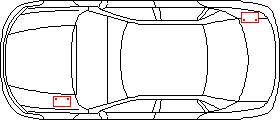
This page does not refer to the serially switched batteries which are used in in utility vehicles. You can read up on these here. |
The batteries, even those used nowadays are, due to their basic construction, among the oldest electrical components in modern vehicles. At the same time, the demands made of them are constantly growing,
although substantial power saving would be possible in the case of the starter-motor, which is the strongest consumer. This does not mean the one-off strain on the battery when starting the engine, but the constant
demands made by the multitude of other consumers.
Batteries in mid-range cars allow nominal currents of up to 900 A. Ten-cylinder Diesel-engines are fitted with 85 Ah starter batteries. This is why in future there will be hardly any one liter cars, because in a number of
vehicles, the consumption necessary to produce the electric current is higher. Therefore it's not surprising, that with the size of the batteries, the desire also grew, to divide them into batteries of a customary
commercial size and thus guarantee the starting performance. The first ones are already found in the larger upper-class vehicles, those with the highest current demand.
Of the two batteries, one is responsible for the starting procedure and one is for the on-board electrical system. Sophisticated on-board electronics make sure that there is always sufficient energy for the starter
battery. This creates a higher performance density, the capacity and the weight are lower. The latter in particular, enables them to be placed up front in the engine compartment and near to the starter. This way, the
generally quite thick starter-cable is kept short. The other one, the rather heavier battery, almost as a counterweight, is installed in the rear. It's capacity is determined by the needs of the remaining electrical system.
During the starting procedure it can be separated, which protects the control devices from having too little tension.
Within certain tolerances, one of the batteries may support the other. This is why the starter battery does not have to be laid out for the maximum cold-starting current and the relevant consumers, because it can be
supported by the on-board system battery when cold starting. When warm starting the two are always separated. All this is controlled by a management, which also reacts when the system is overloaded. In this case,
the power supply to certain comfort-features may be reduced or even completely switched off.
In the supervision of the electrical system, which by the way, is nowadays found in much cheaper vehicles without twin-batteries, there are sensors for the battery current and -temperature, at least one control device
and a controlled relay. Through the CAN-Bus contact is made with, among other things, the dashboard controller, e.g., to
switch off unnecessary heating consumers when the current level is low. Then of course, provision must still be made for the display. The controller even registers accident occurences from the air-bag controllers. In
this case, all or at least, certain parts of the voltage production are switched off, indeed, sometimes so much so that one has to take the car to a workshop to have the circuit reset. Indeed, this is probably necessary
anyhow due to the damage caused by the accident.
One problem that also becomes apparent, not only in the case of twin-batteries, is the installation in the luggage compartment, this does not play such an important role when the battery is installed in the engine
area. Batteries are sensitive to excessive heat or cold. In the engine compartment they are always installed where the working temperature is neither too high nor too low. Earlier, some were even supplied with their
own cooling fan. All this has to be taken into consideration when installing the battery in the boot. In addition - except in the case of completely maintenance-free batteries - there is also the possibility of escaping
gases. Thus, the storage space for the battery must also be sufficiently ventilated. 11/12